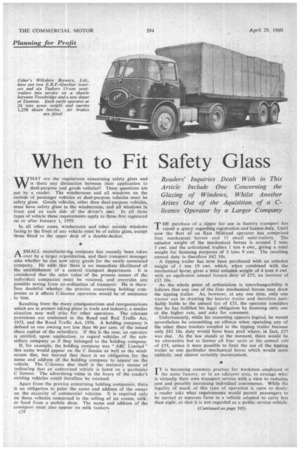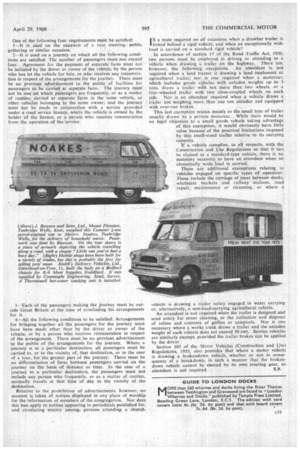When to Fit Safety Glass
Page 66

Page 69

If you've noticed an error in this article please click here to report it so we can fix it.
Readers' Inquiries Dealt With in This Article Include One Concerning the Glazing of .WindOws, Whilst Another Arises Out of the Aquisition of a C.licence Operator by a Larger Company WHAT are the regulations concerning safety glass and is there any distinction between their application to dual-purpose and goods vehicles? These questions are put by a reader. The windscreens and all windows on the outside of passenger vehicles or dual-purpose vehicles must be safety glass. Goods vehicles, other than dual-purpose vehicles, must have safety glass in the windscreens, and all windows in front and on each side of the driver's seat. In all three types of vehicle these requirements apply to those first registered
on or after January 1, 1959. , , .
In all other cases, windscreens and other outside windows facing to the front of any vehicle must be of safety glass, except those fitted to the upper deck of a double-decker.
ASMALL manufacturing company has recently been taken over by a larger organization, and their transport manager asks whether he can now carry goods for the newly associated company. He adds that there is no immediate likelihood of the establishment Of a central transport department. It is considered that the sales value of the present names of the individual companies must be retained, and overrides any possible saving from co-ordination of transport. He is therefore doubtful whether the proviso concerning holdingcompanies as it affects C-licence operation would be of assistance to him.
Resulting from the many amalgamations and reorganizations which are at present taking place in trade and industry, a similar situation may well arise for other operators. The relevant provisions are contained in the Road and Rail Traffic Act, 1933, and the Road Traffic Act, 1956. A holding company is defined as one owning not less than 90 per cent, of the issued share capital of. the subsidiary. If this is the case, an operator is entitled, upon application, to regard vehicles of the subsidiary company as if they belonged to the holding company. If, for example, the holding company was "ABC Limited" this name would appear on the C licence as well as the windscreen disc, but beyond that there is no obligation for the name and address of the holding company to appear on the vehicle. The C-licence disc itself is the statutory means of indicating that an authorized vehicle is listed on a particular C licence. The advertising value in the livery of the reader's existing vehicles could therefore be retained.
Apart from the proviso concerning holding companies, there is no obligation to paint the name and address of the owner on the majority of commercial vehicles. It is required only on those vehicles concerned in the selling of ice cream, milk, Or food from a mobile shop. The name and address of the consignor must also appear on milk tankers.
c28
THE purchase of a tipper for use in factory transport has raised a query regarding registration and licence duty. Until now the fleet Of an East Midland operator has comprised four mechanical horses and 15 small semi-trailers. The unladen weight of the mechanical horses is around. 2 tons 5 cwt. and the articulated trailers 1 ton 4 cwt., giving a total weight for licensing purposes of 3 tons 9 cwt. The resulting annual duty is therefore £42 10s.
A tipping trailer has now been purchased with an unladen weight of 1 kin 19 cwt. which, when combined with the mechanical horse; gives a total unladen weight of 4 tons 4 cwt. with an equiValent annual licence duty of £55, an increase of 112 10s.
As the whole point of articulation is interchangeability it follows that any one of the four mechanical horses may draw the tipping trailer. As, however, at any one time, only one tractor can be drawing the heavier trailer and therefore justifiably liable to the annual tax of £55, the operator considers that he has fulfilled his legal obligation by licensing only one at the higher rate, and asks for comment.
Unfortunately, while his reasoning appears logical, he would nevertheless be committing an offence when operating any of the other three tractors coupled to the tipping trailer because only £42 10s. duty would have been paid where, in fact, £55 was due. As the la* stands at the moment, there would be no alternative hut to license all four units at the annual rate of 155, unless it were possible to limit the use of the tipping trailer to one particular mechanical horse which would seem unlikely, and almost certainly inconvenient.
IT is becoming common practice for workmen employed at the same factory, or in an adjacent area, to arrange what is virtually their own transport service with a view to reducing cost and possibly increasing individual convenence, While the legality of much of this type of operation is open to doub, a reader asks what requirements would permit passengers to be carried at separate fares in a vehicle adapted to carry less than eight, so that it is not regarded as a public service vehicle.
One of the following four requirements must be satisfied: 1—It is used on the occasion of a race meeting, public gathering or similar occasion.
2—It is used on a journey on which all the following conditions are satisfied: The number of passengers must not exceed four. Agreement for the payment of separate fares must not be initiated by the driver or owner of the vehicle, by the person who has let the vehicle for hire, or whoreceives any remuneration in respect of the arrangements for the journey. There must be no previous advertisement to the public of facilities for passengers to be carried at separate fares, The journey must not be one on which passengers are frequently, or as a matter of routine, carried at separate fares in the same vehicle, or other vehicles belonging to the same owner; and the journey must not be made in conjunction with a service provided under a road service licence, where the vehicle is owned by the holder of the licence, or a person who receives remuneration from the operation of the service.
3—Each of the passengers making the journey must be outside Great Britain at the time of concluding his arrangements for it.
4—All the following conditions to be satisfied: Arrangements for bringing together all the passengers for the journey must have been made other than by the driver or owner of the vehicle, or by a person who receives remuneration in respect of the arrangement. There must be no previous advertisement to the public of the arrangements for the journey. Where a journey is to a particular destination, all passengers must be carried to, or to the vicinity of, that destination, or in the ease of a tour, for the greater part of the journey. There must be no differentiation of fares between passengers carried on the journey on the basis of distance or time. In the case of a journey to a particular destination, the passengers must not include any person who frequently, or as a matter of routine, normally travels at that time of day to the vicinity of the destination.
Relative to the prohibition of advertisements, however, no account is taken of notices displayed in any place of worship for the information of members of the congregation. Nor does this ban apply to notices appearing in periodicals published for, and circulating mainly among, persons attending a 'church.
IS a mate required on all occasions when a drawbar trailer is towed behind a rigid vehicle, and when an exceptionally wide load is carried on a standard rigid vehicle?
In accordance of section 17 of the Road Traffic Act, 1930, two persons must be employed in driving or attending to a vehicle when drawing a trailer on the highway. There are, however, the following exceptions. An attendant is not required when a land tractor is drawing a land implement or agricultural trailer, nor is. one required when a motorcar, which includes goods vehicles with unladen weights up to 3 tons, draws a trailer with, not more than two wheels, or a four-wheeled trailer with two close-coupled wheels on each side. Nor is an attendant required when a vehicle draws a trailer not weighing more than one ton unladen and equipped with over-run brakes.
This last exemption relates mainly to the small type of trailer usually drawn" by a private motorcar. While there would be no legal objection to a small goods vehicle taking advantage of this exemption, it would obviously have little value because of the practical limitations imposed by this small-sized trailer relative to its carrying capacity.
If a vehicle complies, in all respects, with the Construction and Use Regulations so that it can be classed as a standard-type vehicle, there is no statutory necessity, to have an attendant when an abnormally wide load is carried.
There are additional exemptions relating to vehicles engaged on specific types of operation. These include the carriage of meat between docks, wholesale markets and railway stations, road repair, maintenance or cleansing, or where a vehicle is drawing a trailer solely engaged in water carrying or, alternatively, a non-load-carrying agricultural vehicle.
An attendant is not required when the trailer is designed and used solely for street cleaning, or the collection and disposal of refuse and contents of gullies or cesspools. Nor is one necessary where a works truck draws a trailer and the unladen weight of each vehicle does not exceed 30 cwt. Service vehicles are similarly exempt. provided the trailer brakes can be applied by the driver.' Section 105 of the Motor Vehicles (Construction and Use) Regulations, 1955, also provides that where a motor vehicle is drawing a brokendown vehicle, whether or not in consequence of a breakdown, in such a manner that the brokendown vehicle cannot be steered by its own steering gear, an
attendant is not required. S.D.












































































































